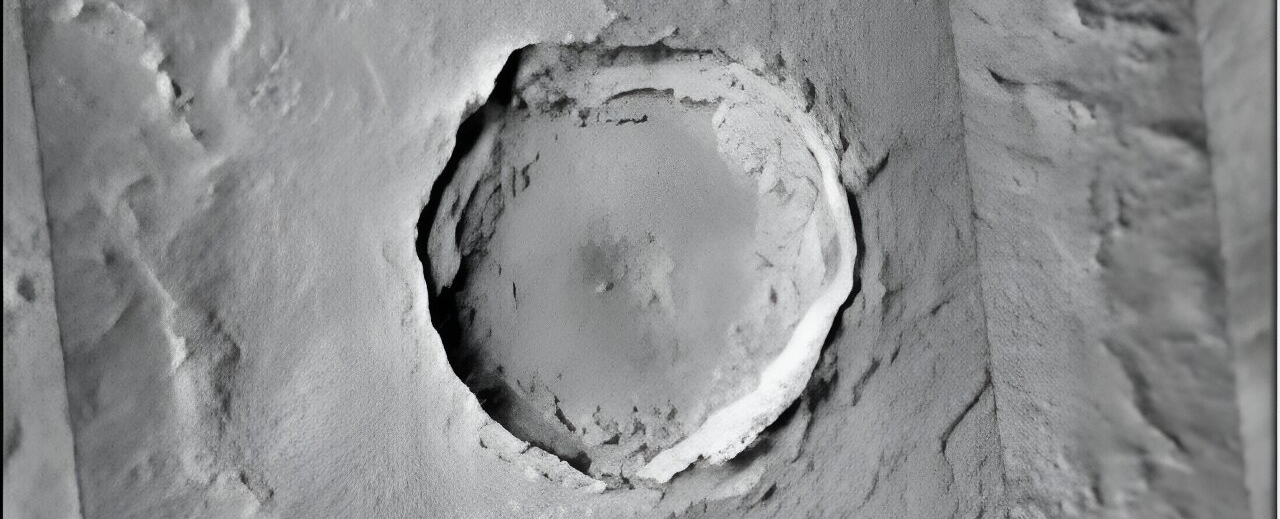Products You May Like
There are plenty of craters on Mars, especially when compared to Earth. That is primarily thanks to the lack of weathering forces and strong plate tectonics that disrupt the formations of such impacts on our home planet.
However, not all impact craters on Mars are directly caused by asteroid impacts. Many of them are caused by the ejecta from an asteroid impact falling back to the planet. One recent study showed how impactful this can be – it concludes that a single large impact crater on Mars created over two billion other smaller craters up to almost 2000 km away.
The study, released at the 55th annual Lunar and Planetary Science Conference in Texas, focuses on a crater called Corinto. It’s located in Elysium Planitia, only about 17 degrees north of the Red Planet’s equator.
It’s a relatively young crater by Martian standards, with the scientists’ best estimate of its age being around 2.34 million years ago. It’s pretty massive for being that young, though, as the average time between impacts of its size is around 3 million years. As such, the scientists think it might be the most recent crater of its size on Mars.
That’s not why it’s interesting, though. It has an extensive “ray system”. That means that a significant amount of ejecta was cast out from the impact site and landed elsewhere on the planet, creating “rays” from the central impact point that can be seen on a map of the planet’s surface even today.
allowfullscreen=”allowfullscreen” class=”youtube-player” frameborder=”0″>
Corinto crater is about 14 km in diameter and 1 km deep. Its interior bowl is pock-marked with other, smaller craters that happened its impact. Indications suggest it was full of water ice when it was hit, as there appeared to be some degassing of the superheated ice after the impact. Calculations point to a relatively steep impact angle of about 30-45 degrees from straight on – and the impactor appeared to be coming from the north.
As a result, much of the ejecta impact field lies to the south, especially the southwest, of the crater. While some secondary ejecta craters are sitting to the north of the main one, it appears clear that the impactor’s angle was significant enough to push most ejecta to the south.
Tracking the path of this ejecta a few million years later isn’t easy. Scientists used data collected by HiRISE and the Context Camera (CTX) on the Mars Reconnaissance Orbiter (MRO) and analyzed characteristics of smaller craters surrounding the main Corinto crater. In particular, they looked for craters that looked like they would be caused by ejecta rather than by an interplanetary impactor.

They grouped the different types of ejecta craters they found into five different “facies,” primarily focused on how far away they were from the main crater. Each facies has its distinct characteristics. For example, Facies 0, the one closest to the main crater, are semi-circular, don’t appear to have any ejecta, or have very distinct rims. On the other hand, Facies 3 craters are long and narrow rather than semi-circular (hinting that something rolled through to create them) and have shown up as very bright in the MRO images.
Two main findings from the paper will probably turn the most heads. The scientists found that there are close to 2 billion secondary impact craters larger than 10 meters caused by the ejecta from Corinto. And those secondary craters appear up to 1850 km away. That would make it, by far, the most impactful (pun intended) of the recent Martian craters in terms of the sheer number and distance of its ejecta.
The paper didn’t go into what that might mean for our larger understanding of these processes on the red planet, nor what future work might be completed – the version reviewed for this article was only two pages. But, as with most things in science, a new record for something – in this case, distance and amount of secondary impact craters, attracts additional research, so we’ll have to see what if any, future discoveries can be made regarding this interesting Martian crater.
This article was originally published by Universe Today. Read the original article.
